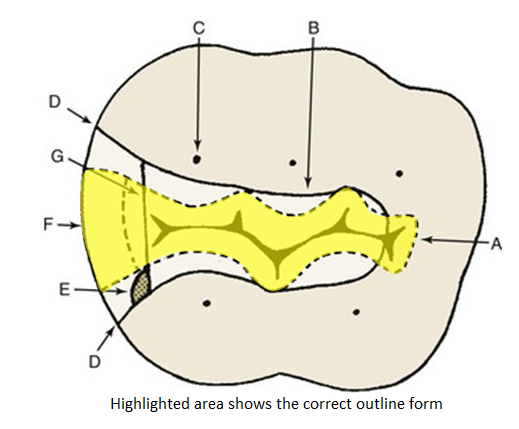Before Fixing that Error…
When you encounter such errors, you have to decide whether if it is within your ability to fix it or not because more often than not most of the students would say that they rather made everything even worse when they fix things. Before anything else, you must always think that there is no such thing as a perfect preparation. Even the very skillful operator will always encounter some aspects in their work that they find that is off. The only difference between them and you is that they just have a higher standard of technique. So before getting into working on that mistake weigh in first if that is a clinically acceptable mistake or is it a very bad mistake. It is okey to leave a clinically acceptable mistake (none to less deduction of points) rather than trying to fix it but eventually wrecking it up even more.
A clinically acceptable feature is like this, imagine a proximal box that is too big but it is still acceptable because you wanted to make a clearance from the adjacent tooth. Or having a lingual s-curve because you want to extend your lingual walls to create clearance while preserving the ML cusp. Or your distal wall has minimal to no divergence but maintained a good, thick remaining marginal ridge. So a clinically acceptable mistake is not a mistake at all but it is something that you do (or have done mistakenly) but still remained in virtue to the principles of cavity preparation.
Now compare those situations to a very huge mistake like unsupported enamel. Yes, you have done a good prep in terms of its outline form, measurements and angulations but your buccal-lingual walls of your proximal box have enamel lips. This is a very big deduction to your points because enamel lips literally defies the principle of the resistance form. No one will ever tell you to leave unsupported enamel because of some reason. Or leaving closed contact walls because your proximal box is too big already. But according to convenience form, you really need to break that contact.
So it is just a matter of weighing things out and reflect on to that whether it is still follows the principles. Bear this question in mind, “Is this “mistake” worth trying to fix or not?”
Next, if you really need to fix a mistake, you first need to think of your objective. After you fix this one, what would you expect to see on your prep. The mistake of others is that they do not carefully plan and just do whatever hoping that it will work. Please carefully plan your objective first and then plan on how you would do it.
Your experience also bears a factor for correcting mistakes. Questioning yourself like, “How did I do when I was correcting this kind of mistake, was I always successful or not?” So whatever it is, leaving or correcting mistakes will always follow the principles of cavity preparation.
LINK SECTION for Common Errors and Prevention

